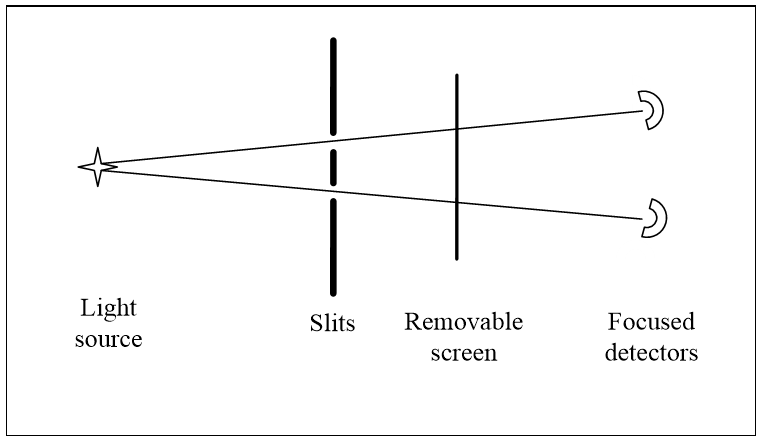
That photons travel about a foot per nanosecond allows a delayed choice two-slit experiment. Two detection options are used, either the usual screen, or telescopes that focus on one slit or the other (Figure 3.21). The trick is that the choice between them is made after the photon passes the slits, when the screen is either quickly removed or not. If the screen is used, there is interference, so the photon passed though both slits, but if the telescopes are used, only one fires, so it just took one path. The conclusion that a detector turned on after the photon passes the slits decides the path it took before that implies that the future can change the past:
“It’s as if a consistent and definite history becomes manifest only after the future to which it leads has been settled.” (Greene, 2004), p189.
The distances involved are irrelevant, so a photon could travel from a distant star for a million years, then decide, when it hits a telescope on earth, if it physically came via galaxy A or B. As Wheeler says:
“To the extent that it {a photon} forms part of what we call reality… we have to say that we ourselves have an undeniable part in shaping what we have always called the past.” (Davies & Brown, 1999), p67.
But if the future can affect the past, then all of physics is in doubt! A processing model avoids this by letting a photon take every path and pick one when it arrives. In computing, leaving choices until the last possible moment is called just-in-time management, as it lets supermarkets restock based on current point-of-sale data rather than historical estimates.
In Figure 3.21, the photon is immune to delayed events thanks to just-in-time management. It goes through both slits as usual, and if a screen is there gives interference, but if not, just carries on until it hits a telescope, which restarts it with a path that went through one slit. If the screen is there, we conclude the photon went through both slits, but if the telescopes are there, we conclude it went through one slit. Yet swapping the screen in and out after the photon passes the slits doesn’t matter at all, because the physical event that defines the path occurs on arrival.
If light is made of particles, delayed choice experiments imply backwards causality, but if it is a processing wave, the causality that physics relies upon remains intact.